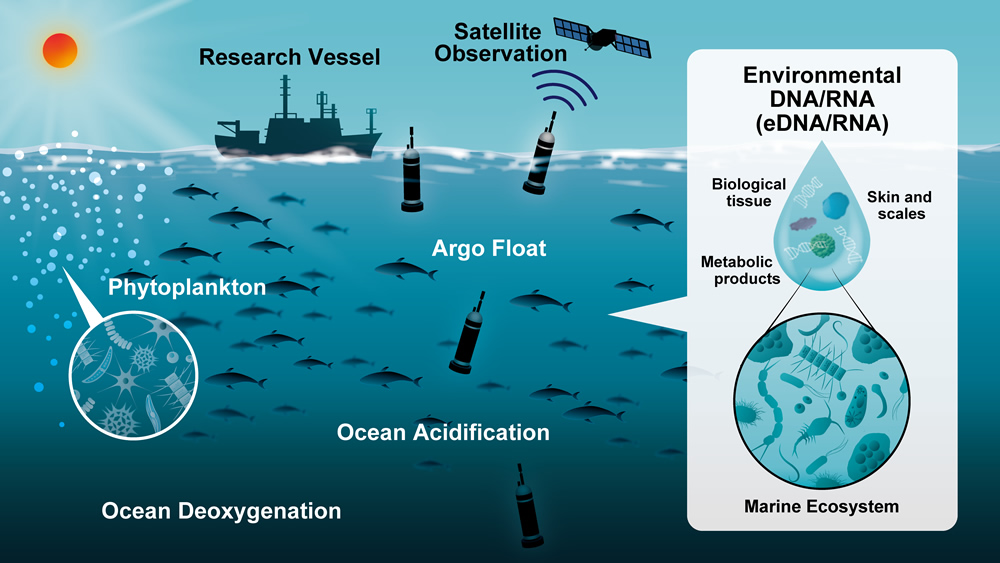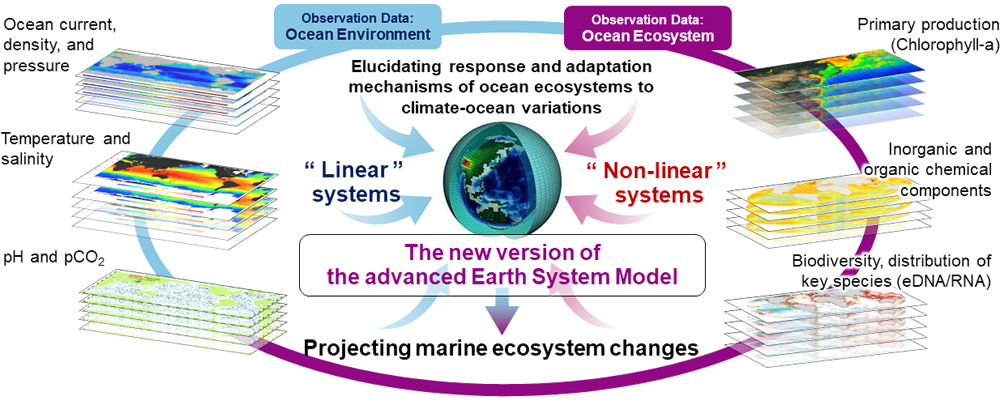- HOME
- Research
Research
Research Content
As one of the targets for cross-disciplinary and fusion research on the response and adaptation mechanisms of marine ecosystems to environmental change, we will focus on "regime shifts", which are broad, rapid, and major structural changes in climate and ecosystems.
This phenomenon is thought to be essentially due to the interlocking and nonlinear interactions between variations at different spatiotemporal scales in the marine environment, as well as stronger nonlinearities in ecosystem responses, but the detailed mechanisms have not yet been elucidated.
Deepening our understanding of the mechanisms of ecosystem change through the elucidation of regime shifts is expected to lead to an understanding of the tipping points associated with global warming.
At this institute, we will promote research centered on the following research themes and develop fusion research by aggregating the scientific knowledge and data obtained.
Research theme I:
Deciphering Climate-Ocean-Ecosystem Interactions and Regime Shift
The decadal-scale variations in the stability of the Kuroshio Current, which are linked to the Pacific Decadal Oscillation, affect short-period variations such as seasonal cycles and daily fluctuations, as well as medium-scale variations such as front waves and ocean eddies. Over the past 30 years, multiple observation projects have been conducted to comprehensively understand the Northwest Pacific, making it one of the most advanced regions in the world for understanding environmental field variations from decadal to seasonal scales. Combining this knowledge with the latest autonomous platform (Argo floats, ocean gliders, etc.) and seafloor cable observation data will enable us to understand variability across a wide range of spatiotemporal scales. Furthermore, the detailed information on environmental variability can be effectively integrated with environmental genome (eDNA) information, biogeochemical data, genomic-level plasticity, and adaptive evolutionary process data. Through statistical methods and machine learning, we will hierarchically extract temporal and spatial patterns of variations in marine environmental disciplines and lower trophic level ecosystems, ranging from coastal to open ocean, surface to mesopelagic depths, and from daily to decadal changes, revealing the interconnections among different time and variable scales.

Research theme II:
Ecosystem Response, Adaptation, and Evolution Mechanisms to Environmental Changes
Mechanisms of Ecosystem Response, Adaptability, and Evolution under Environmental Change To understand the response and adaptation mechanisms of marine ecosystems, it is essential to comprehensively understand biological responses across various levels, from individuals to populations, to communities and whole ecosystems. Marine microbial ecosystems support primary production in surface waters and directly influence the diversity, abundance, and movement of organisms higher up in the food web. Ecological theory suggests that changes in species interactions occur much faster than inter-generational changes, and that the accumulation of these changes impacts ecosystem dynamics at larger scales (community and ecosystem levels). Tohoku University has been conducting eDNA monitoring along the coast of Japan (ANEMONE) for more than 10 years, analyzing non-equilibrium and non-linear species interactions. We have also established dynamic stability indicators for ecosystems and successfully evaluated community and inter-species level ecosystem responses to seasonal changes.
To understand non-equilibrium and nonlinear species interactions with dynamic stability indicators of ecosystems, the WPI-AIMEC will maximize opportunities provided by JAMSTEC and the University of Hawai‘i’s observation stations, marine surveys, and in situ eDNA/RNA surveys with new sampling and analytical devices to expand the application of spatio-temporal eDNA analysis to the Northwestern Pacific region. Global warming is having an impact on and putting strain on all of the earth's ecosystems, accelerating the loss of biodiversity. To elucidate the potential responses, adaptability, and limits of marine ecosystems under environmental fluctuations, we will also use “culturomics” approaches, including in situ and in vitro experiments with environmental stressors, to reveal the responses at the gene expression-, isotopic fractionation-, and metabolite-levels.

Research theme III:
Projection of Marine Ecosystem Changes
To quantitatively capture the relationships between environmental changes and productivity for future projections, it is necessary to understand and accurately reproduce the mechanisms by which disturbances in the physical environment affect marine ecosystems and their productivity.
The ocean general circulation model developed by JAMSTEC has a horizontal resolution of approximately 10 km and reproduces the marine physical environment, covering the entire ocean and representing medium-scale eddies to some extent. By developing new marine ecosystem modules that incorporate the results and theory from Themes I and II, we aim to comprehensively understand the interactions between the physical environment and ecosystems in terms of material cycling. In addition, we will develop methods to convert biological distributions into functions for material cycling and climate processes. We will also leverage Machine Learning (ML) and Artificial Intelligence (AI) approaches to advance our understanding of ecosystem changes and their feedback mechanisms with the marine environment and human activities, as well as to enhance our ability to make projections of future changes and their impacts.

Fusion research
Clarifying the ecological response and adaptation mechanisms, including the mystery of “regime shifts”, will require observations of a wide range of physical and biological phenomena with high resolution (in both space and time) as well as extensive numerical modeling. By utilizing satellites, advanced robotic biogeochemical Argo floats, and submarine cable observation networks, we will conduct high spatio-temporal resolution observations in the dynamic Kuroshio region and coastal areas in Theme I. By integrating data from such observations with the numerical models of Theme III, we will achieve a comprehensive understanding and detailed (fine resolution) reproduction of the key phenomena. Furthermore, through mathematical and data sciences that incorporate Machine Learning (ML) and Artificial Intelligence (AI), we will analyze the correlations between the short-term variability patterns revealed in Theme I and the dynamic stability indicators of biodiversity and functionality clarified in Theme II. That novel combination will reveal ecological responses and functional relationships in unprecedented detail, which will in turn allow us to achieve a new holistic understanding of the stability and adaptability of marine ecosystems and potential feedback mechanisms with the Earth’s environment.
Combining the results of Themes I, II, and III and assimilating data from observations and experiments will allow us to test models and their underlying hypotheses against environmental fields in the context of real decadal-scale changes in the marine environment and ecosystems. In addition, by making projections of specific variables related to, for example, fisheries and Harmful Algal Blooms (HABs), we will achieve new understanding of the interacting impacts of human activities and ecosystem services.


